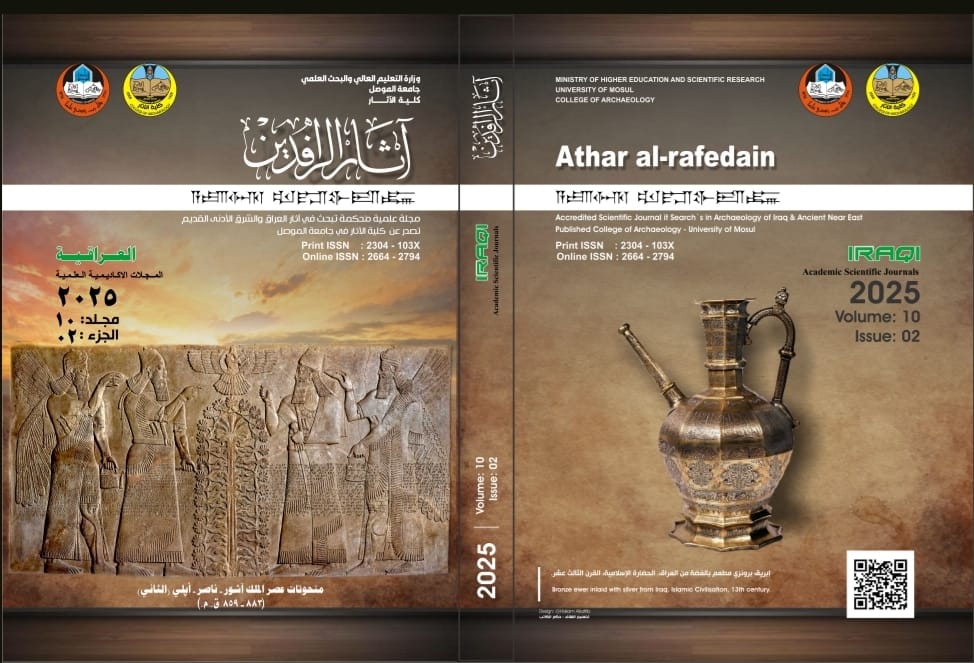Abstract
Ummān-Manda” is a name that means “Manda’s forces” in Akkadian Language. It was mentioned in cuneiform written sources since the beginning of the second millennium BC, and it indicated a group of people moving in many and distant geographical areas, within the framework of northern and eastern Mesopotamia, that is, the regions of Kurdistan, Zagros, and what is related to them. It also had a presence in the northern Syrian coast.
The texts portrayed it as the source of violence, evil, and constant danger that could befall the centres of civilization in the countries of Babylon, Assyria, and elsewhere, and described it with the Akkadian phrase, “the offspring of destruction zēr ḫalqati”
This research paper aims to provide a comprehensive picture of the group’s historical role over the long period of time documented by the texts and seeks to define the features of its identity based on the approach of distinguishing the geographical frameworks of its existence and spread, then linking that presence to historical events, and explaining the nature of its relationship with the peoples of the region.
The texts portrayed it as the source of violence, evil, and constant danger that could befall the centres of civilization in the countries of Babylon, Assyria, and elsewhere, and described it with the Akkadian phrase, “the offspring of destruction zēr ḫalqati”
This research paper aims to provide a comprehensive picture of the group’s historical role over the long period of time documented by the texts and seeks to define the features of its identity based on the approach of distinguishing the geographical frameworks of its existence and spread, then linking that presence to historical events, and explaining the nature of its relationship with the peoples of the region.
Keywords
Ancient East
cuneiform writings
Hurrians
Ummān- Manda
Zagross.
Abstract
\"أومّان مَنْداummān Manda \" تسميةٌ تعني باللغة الأكّدية \"قوّات مَنْدا، حشود الأعداء\". تردّدت في المصادر الكتابية المسمارية الأكّدية (البابلية والآشورية) والحثّية منذ مطلع الألف الثاني ق.م، وكانت تدلّ على قوّات أو جماعات بشرية متنقلة في بقاعٍ جغرافية عديدة ومتباعدة، ضمن إطار شماليّ بلاد الرافدين وشرقيّها، أي مناطق كردستان وزاكروس وما يتصل بها، كما كان لها وجودٌ في شمالي الساحل السوري.
كانت مجموعات مقاتلة، شديدة البأس. تغزو وتدمر، ويثير ذكرُها الرعبَ في نفوس الآخرين. وتقوم بالارتزاق وتأدية خدماتٍ للقوى السياسية الحاكمة، وتماثلت بذلك نسبياً مع جماعات الخبيرو والخبّاتوم في شمالي بلاد الرافدين، والسوتو في وادي الفرات الأوسط، وقوات شالا في المملكة الحثية.
صوّرتها النصوص بأنها مصدر العنف والشر والخطر الدائم الذي يمكن أن يحدق بمراكز الحضارة في بلادي بابل وآشور وغيرهما، ووصفتها بالعبارة الأكدية \"نسل الدمار zēr ḫalqati\".
يستهدف هذا البحث تقديم صورة شاملة عن الدور التاريخي للجماعة في المدة الزمنية الطويلة التي توثقها النصوص، ويسعى إلى تحديد ملامح هويتها اعتماداً على منهج تمييز الأطر الجغرافية لوجودها وانتشارها، ثم ربط ذلك الوجود بالأحداث التاريخية، وبيان طبيعة علاقتها بشعوب المنطقة.
كانت مجموعات مقاتلة، شديدة البأس. تغزو وتدمر، ويثير ذكرُها الرعبَ في نفوس الآخرين. وتقوم بالارتزاق وتأدية خدماتٍ للقوى السياسية الحاكمة، وتماثلت بذلك نسبياً مع جماعات الخبيرو والخبّاتوم في شمالي بلاد الرافدين، والسوتو في وادي الفرات الأوسط، وقوات شالا في المملكة الحثية.
صوّرتها النصوص بأنها مصدر العنف والشر والخطر الدائم الذي يمكن أن يحدق بمراكز الحضارة في بلادي بابل وآشور وغيرهما، ووصفتها بالعبارة الأكدية \"نسل الدمار zēr ḫalqati\".
يستهدف هذا البحث تقديم صورة شاملة عن الدور التاريخي للجماعة في المدة الزمنية الطويلة التي توثقها النصوص، ويسعى إلى تحديد ملامح هويتها اعتماداً على منهج تمييز الأطر الجغرافية لوجودها وانتشارها، ثم ربط ذلك الوجود بالأحداث التاريخية، وبيان طبيعة علاقتها بشعوب المنطقة.
Keywords
الشرق القديم، الكتابات المسمارية، الحوريون، أومّان مَنْدا، زاكروس
